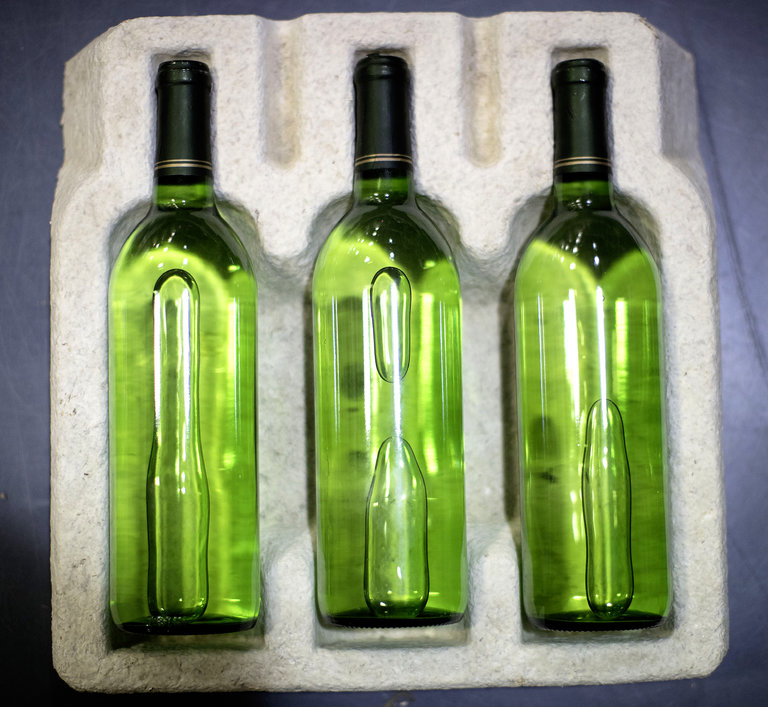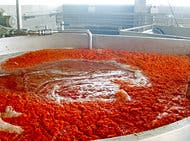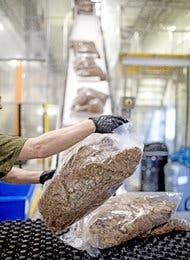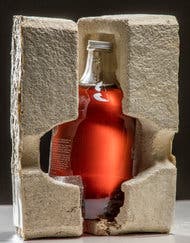Source: nytimes.com
Published: May 30, 2017

The design company Ecovative makes a variety of packaging materials using mycelium fungus. Credit: Nathaniel Brooks for The New York Times
For the environmentally conscious eater, they are among the most inconvenient truths: Too much food goes to waste. Too much packaging comes with the food. And too much of the packaging is made to last for ages.
Now there may be a single answer to all three problems: using excess food to make the packaging.
A growing number of entrepreneurs and researchers are working to turn foods like mushrooms, kelp, milk and tomato peels into edible — if not always palatable — replacements for plastics, coatings and other packaging materials.
Their efforts come as food and beverage companies are not only looking for biodegradable containers — Nestlé Waters and Danone recently announced a joint project to make water bottles from wood — but also joining in the growing effort by governments, restaurateurs and consumers to reduce waste, which contributes to the greenhouse gases enveloping the planet.
The United States Department of Agriculture, for instance, is giving new meaning to the notion of pizza with extra cheese: A team at its research laboratory in Wyndmoor, Pa., has developed a material from milk protein that can be used to line pizza boxes, encase cheese or create, say, soluble soup packets that can simply be dropped in hot water.
The product could even serve as a substitute for the sugar used to coat cereal flakes to prevent them from going soggy too fast, said Peggy Tomasula, a research leader at the laboratory — although she also noted that at this point, it may be uneconomical for some applications.
The project grew out of the Agriculture Department’s search for ways to put some of its stockpiles of milk powder to use; fluid milk consumption has steadily declined for years, but federal subsidies for the dairy industry have kept production humming.
The Merck Forest and Farmland Center, a nonprofit environmental group in Rupert, Vt., that supports itself by selling maple syrup, faced a quandary of its own.

Researchers in Italy are using tomato skins to make a lining for cans and other containers.Credit…SSICA
“We were going to great expense to make maple syrup and even somewhat more expense to get organic certification — and then shipping it in all this plastic,” said Tom Ward, a former executive director of the center, referring to the containers and foam pellets it used to ship orders. “That just seemed nonsensical.”
So for the past two years, the group has sent its syrup out in glass bottles cradled in a molded material made from mushrooms. “You can literally break it up and put it in a compost pile, then scatter it around your rose bushes,” Mr. Ward said. “I think what we’re doing is a microcosm of what’s coming in terms of products that are sustainable from start to finish.”
That mushroom-based packaging is the invention of Ecovative, a design company in Green Island, N.Y. “I studied mechanical engineering, and as I was working on turbines, I couldn’t forget what I saw as a child growing up on a farm in Vermont,” Eben Bayer, a founder, said. “Biology really is the best technology available, and we’ve started thinking about living cells more as living machines.”
The Ecovative product is made using the mycelium fungus that forms the roots of mushrooms as they grow in environments like piles of dead leaves or compost. Ecovative grows the fungus in a variety of substances, which lead to materials of different strengths, flexibility and durability.
“You could eat it,” Mr. Bayer said, “although we don’t encourage that,”
Over the past several years, governments have quietly bankrolled efforts to develop packaging from food. The European Union, which underwrote a project to develop coatings from whey and potato proteins from 2011 to 2015, estimates that the global market for so-called bioplastics is growing by as much as 30 percent each year.
Bringing those products to market, however, is a challenge. The Agriculture Department, for example, tried to build interest in a milk-protein-based product more than a decade ago but found no takers, Dr. Tomasula said. Cost and the fact that it was susceptible to moisture made it a hard sell.
“Edible films were just getting started then, and there were a lot of people playing around with them,” she said. “But food waste and food security weren’t big issues then, and nobody really seemed to notice them.”
Times have changed. Mike Lee, the founder of the Future Market, a firm that forecasts trends, has been keeping an eye on products like the cheese packaging. “I can even see a grocery store free of conventional packaging some day,” Mr. Lee said.

A worker breaking up mycelium before feeding it into a machine.Credit…Nathaniel Brooks for The New York Times
But he sees hurdles. “Even though these products are important,” he said, “until someone steps up and says, ‘I’m going to use it on a big scale,’ they’re just science looking for an application.”
Big companies like PepsiCo and Nestlé are more interested today than they were years ago, goaded by consumers who are increasingly aware that the food they eat and its packaging can damage the environment.
The companies remain skeptical, however. “Some of the stuff out there is just gimmicky,” said David Strauss, the head of packaging in Nestlé’s United States operations. “They sound nice but will never be cost-competitive or, in a final analysis, don’t have the impact on waste or the environment that the people making them promise.”
Then there is the issue of food security: Nestlé says it wouldn’t want its demand for packaging to reduce the food supply, given widespread hunger. “It’s no good to package our products in a packaging that could instead have been used to feed people,” Mr. Strauss said.
Few, however, are begging to eat the peels left after tomatoes are processed. A group of researchers in Italy has used them to develop a lining for cans.
Called Biocopac Plus, the product aims to replace BPA, or Bisphenol A, which is used in coatings for cans and bottles that contain foods and drinks. Small amounts of BPA can migrate into foods, raising concerns among some consumers and health advocates, despite assurances from American and European regulators that it is safe.
“We extract a natural polymer from tomato skins, and using that, we produce a lacquer to protect food packaged in metal cans,” said Angela Montanari, the head of packaging at the Experimental Station for the Food Preserving Industry in Parma, Italy. “It can be used to pack tomatoes, peas, meat, fish, all kinds of foods that are canned.”
Originally underwritten by the European Union, the project is being advanced by a group that includes a large Italian family-owned farming business, a major Italian food processor and a manufacturer of industrial coatings. The group is building a pilot plant in Mantua, Italy, to make the coating.

Molded packing material by Ecovative made from a mushroom-type fungus.Credit…Tony Cenicola/The New York Times
The Wyss Institute for Biologically Inspired Engineering, at Harvard, has extracted chitosan, a polysaccharide, from shrimp and lobster shells and combined it with silk fibers to create an alternative to plastic packaging, called Shrilk.
“We put it in different layers, like an insect’s wing, and demonstrated that you can make sheets that look something like Saran Wrap and are much stronger,” said Robert Cunningham, the director of platform development at the Wyss Institute.
Dr. Cunningham said Shrilk could be used to make egg cartons or a wrap for lettuces. He said that a number of large packaging companies had expressed interest in the product, but that it is not yet cost-competitive. “The next step has to be industry stepping in and changing the economics,” he said.
A British start-up called Skipping Rocks Lab is taking matters into its own hands. The company has developed a packaging it calls Ohoo from edible seaweed, and is building a machine to produce containers from Ohoo to hold water, juices, cosmetics and other liquids on the spot.
A juice bar, for instance, could create a container with each order. “It’s something like an espresso machine that you put on the shelf and make a container from Ohoo while a customer waits,” said Rodrigo Garcia González, a founder of Skipping Rocks.
The company has talked with many of the world’s largest beverage companies, Mr. Garcia González said, but none have yet embraced Ohoo.
“Those conversations are moving quite slowly because this is a product that challenges the status quo,” he said. “And there are people who are making quite a lot of money from the status quo.”
